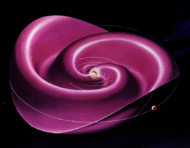
Back عاصفة مغناطيسية أرضية Arabic Tormenta xeomagnética AST Геомагнитна буря Bulgarian Tempesta geomagnètica Catalan Magnetická bouře Czech Solstorm Danish Magnetischer Sturm German Ηλιακή καταιγίδα Greek Tormenta geomagnética Spanish Geomagnetiline torm Estonian

A geomagnetic storm, also known as a magnetic storm, is a temporary disturbance of the Earth's magnetosphere caused by a solar wind shock wave.
The disturbance that drives the magnetic storm may be a solar coronal mass ejection (CME) or (much less severely) a co-rotating interaction region (CIR), a high-speed stream of solar wind originating from a coronal hole.[1] The frequency of geomagnetic storms increases and decreases with the sunspot cycle. During solar maximum, geomagnetic storms occur more often, with the majority driven by CMEs.
The increase in the solar wind pressure initially compresses the magnetosphere. The solar wind's magnetic field interacts with the Earth's magnetic field and transfers an increased energy into the magnetosphere. Both interactions cause an increase in plasma movement through the magnetosphere (driven by increased electric fields inside the magnetosphere) and an increase in electric current in the magnetosphere and ionosphere. During the main phase of a geomagnetic storm, electric current in the magnetosphere creates a magnetic force that pushes out the boundary between the magnetosphere and the solar wind.
Several space weather phenomena tend to be associated with or are caused by a geomagnetic storm. These include solar energetic particle (SEP) events, geomagnetically induced currents (GIC), ionospheric storms and its disturbances that cause radio and radar scintillation, disruption of navigation by magnetic compass and auroral displays at much lower latitudes than normal.
The largest recorded geomagnetic storm, the Carrington Event in September 1859, took down parts of the recently created US telegraph network, starting fires and electrically shocking telegraph operators.[2] In 1989, a geomagnetic storm energized ground induced currents that disrupted electric power distribution throughout most of Quebec[3] and caused aurorae as far south as Texas.[4] The Carrington Event was mild compared with very rare extreme geomagnetic storms called Miyake events, which cause spikes in radioactive carbon-14 in tree rings.
| Part of a series of articles about |
| Heliophysics |
|---|
 |
- ^ Corotating Interaction Regions, Corotating Interaction Regions Proceedings of an ISSI Workshop, 6–13 June 1998, Bern, Switzerland, Springer (2000), Hardcover, ISBN 978-0-7923-6080-3, Softcover, ISBN 978-90-481-5367-1
- ^ Choi, Charles (5 September 2022). "What if the Carrington Event, the largest solar storm ever recorded, happened today?". LiveScience. Future US. Retrieved 26 February 2023.
- ^ "Scientists probe northern lights from all angles". CBC. 22 October 2005.
- ^ "Earth dodges magnetic storm". New Scientist. 24 June 1989.
© MMXXIII Rich X Search. We shall prevail. All rights reserved. Rich X Search